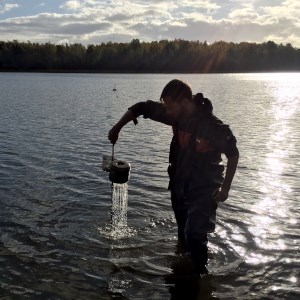Facts:
Participants
SLU: Karin Wiberg, Lutz Ahrens, Frank Menger, Pablo Gago-Ferrero
IDAEA, Barcelona, Spain: Cristina Postigo Rebollo

LakePOPs was a Formas project focusing on the identification of hazardous chemicals in Lake Mälaren.
Lake Mälaren is the major Swedish drinking water source serving 1/3 of the country's population. Conventional drinking water treatment is ineffective in removing micropollutants. Considering that there are >100,000 different chemicals in use in the society, there is a high risk of micropollutants reaching the drinking water consumers.
Micropollutants with persistent (P), bioaccumulative (B) and toxic (T) characteristics are of priority concern. In LakePOPs, we screened for micropollutants in Lake Mälaren and focused on persistent (P) micropollutants in surface water and PB chemicals in sediments. We screened for known emerging pollutants (target screening) as well as previously unknown (or not well known) pollutants using advanced mass spectrometry and by applying a suspect screening research tool, recently developed by our research group. Toxicity and sources of detected micropollutants was also explored.
The ultimate aim was to help the society to reduce human exposure to toxic chemicals by providing new knowledge to incorporate in e.g. Chemicals Action Plans, drinking water directives, and environmental monitoring plans.
Menger F., Ahrens L., Wiberg K., Gago-Ferrero P. (2021). Suspect screening based on market data of polar halogenated micropollutants in river water affected by wastewater. Journal of Hazardous Materials, 401:123377.
Menger F., Gago-Ferrero P., Wiberg K., Ahrens L. (2020). Wide-scope screening of polar contaminants of concern in water: A critical review of liquid chromatography-high resolution mass spectrometry-based strategies. Trends in Environmental Analytical Chemistry, 28:e00102.
Golovko O., Örn S., Sörengård M., Frieberg K., Nassazzi W., Lai F.Y., Ahrens, L. (2021). Occurrence and removal of chemicals of emerging concern in wastewater treatment plants and their impact on receiving water systems. Science of the Total Environment, 754:142122.
Tröger R., Ren H., Yin D., Postigo C., Nguyen P., Baduel C., Golovko O., Been F., Joerss H., Rosa Boleda M., Polesello S., Roncoroni M., Taniyasu S., Menger F., Ahrens L., Lai F.Y., Wiberg K. (2021). What’s in the water? – Target and suspect screening of contaminants of emerging concern in raw water and drinking water from Europe and Asia, Water Research, 198, 15:117099.
Menger F., Boström G., Jonsson O., Ahrens L., Wiberg K., Kreuger J., Gago-Ferrero P. (2021). Identification of pesticide transformation products in surface water using suspect screening combined with national monitoring data, Environmental Science & Technology, 55:15, 10343–10353.
Menger F., Celma A., Schymanski E.L., Lai F.Y., Bijlsma L., Wiberg K., Hernández F., Sancho J.V., Ahrens L. (2022). Enhancing spectral quality in complex environmental matrices: Supporting suspect and non-target screening in zebra mussels with ion mobility, Environment International, 170:107585.
Participants
SLU: Karin Wiberg, Lutz Ahrens, Frank Menger, Pablo Gago-Ferrero
IDAEA, Barcelona, Spain: Cristina Postigo Rebollo